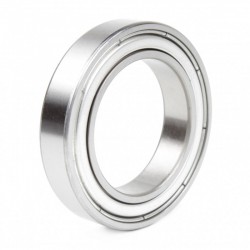Product successfully added to your shopping cart
There are 0 items in your cart. There is 1 item in your cart.
Large delivery of BBC-R bearings. Updating the warehouse.
There are 0 items in your cart. There is 1 item in your cart.
Large delivery of BBC-R bearings. Updating the warehouse.

1.1. Type 0000 - deep groove ball bearing - the most common and simplest bearings, do not require maintenance during operation. Designed to sustain radial and minor axial loads in both directions. These bearings allow only small distortions of shafts in the resistance (to 0,5°), the dimension of which depends on the internal clearences. Herewith, bearing should rotate with low frequency.
The number of structural varieties of these bearings is large enough, but most of them are standardized. Variants of implementations of deep groove ball bearing are as following:
Separators of radial ball bearings are of various designs. The most common are zipper construction of two steel half-separators, connected by rivets. Entire separators made of solid brass, textolite and polyamides, for special working conditions, found its assignment, because of relatively low cost and large option of sizes, what make them quite popular.
1.2. Type 1000 - self-aligning ball bearings - can sustain small radial and axial loads. During vibration motion these bearings perform better than deep groove ball bearings. Bearings of this type fix the position of the shaft in the axial direction on both sides. Structurally, they consist of two rows of balls, inner ring with two rolling raceways and outer ring with one spherical rolling raceway, allowing the inner ring, with a set of balls, rotate around the center of the bearing, i.e. to self-сenter. This ability allows to use them at certain inconsistencies of seats and at higher deflection of rollers. Depending on the series of bearing the permissible distortions of axes can be in between 2-3 degrees. Bearings can have cylindrical or tapered bore of inner ring. Bearings with tapered bores, completed with fastening bushings, which enables their installation on smooth shafts. Separators of spherical ball bearings are typically made of steel. Although, in larger bearings and higher accuracy classes apply entire, mostly brass separators.
1.3. Type 6000 - angular contact ball bearings are able to sustain combined (radial and axial) loads. Their axial load capacity depends on the contact angle. These bearing types 36000, 46000, 66000 are able to take axial loads in one direction. Angular contact ball bearings with three- and four-point contact can sustain axial loads in both directions. Mainly used in medium and high speeds. Angular contact ball bearings, that sustain only one-sided axial loads, require the installation of another bearing which fixes the shaft in the opposite direction. Often, this task is achieved by installing specially matched sets of bearings, with regulated alike gap or tension. They can be supplied in various schemes - O, X, T:
Separators in angular contact ball bearings are made of non-ferrous metals, textolite, plastic and stamped with a steel tape. When using separators made of polyamide or textolite, temperature limits of the materials must be taken into account. It should closely monitor additives that are added into lubricants which can shorten the lifespan of polyamide separator during extended operation of the bearing at temperatures over 100 ° C. At this temperature, the negative impact has rapid aging of the lubricant that should be taken into account, when determining of its replacement term.
1.4 Build 8000 - thrust ball bearings - allow much lower rotation speed compared with other types of ball bearings, because rolling raceway can accept only limited centrifugal loads that occur when moving balls. Bearings with stamped separator or solid are produced in following varieties:
Thrust ball bearings are used in low-speed gears, spindles and rotating centers of metal-cutting machine tools, in jacks, bars, rotary devices, etc. Angular contact ball bearings install as the rotary supports. They can sustain radial, axial and moment loads. Bearings are made of internal and external rings, which have bores for housing on the supporting unit, as well as of external or internal gearing.